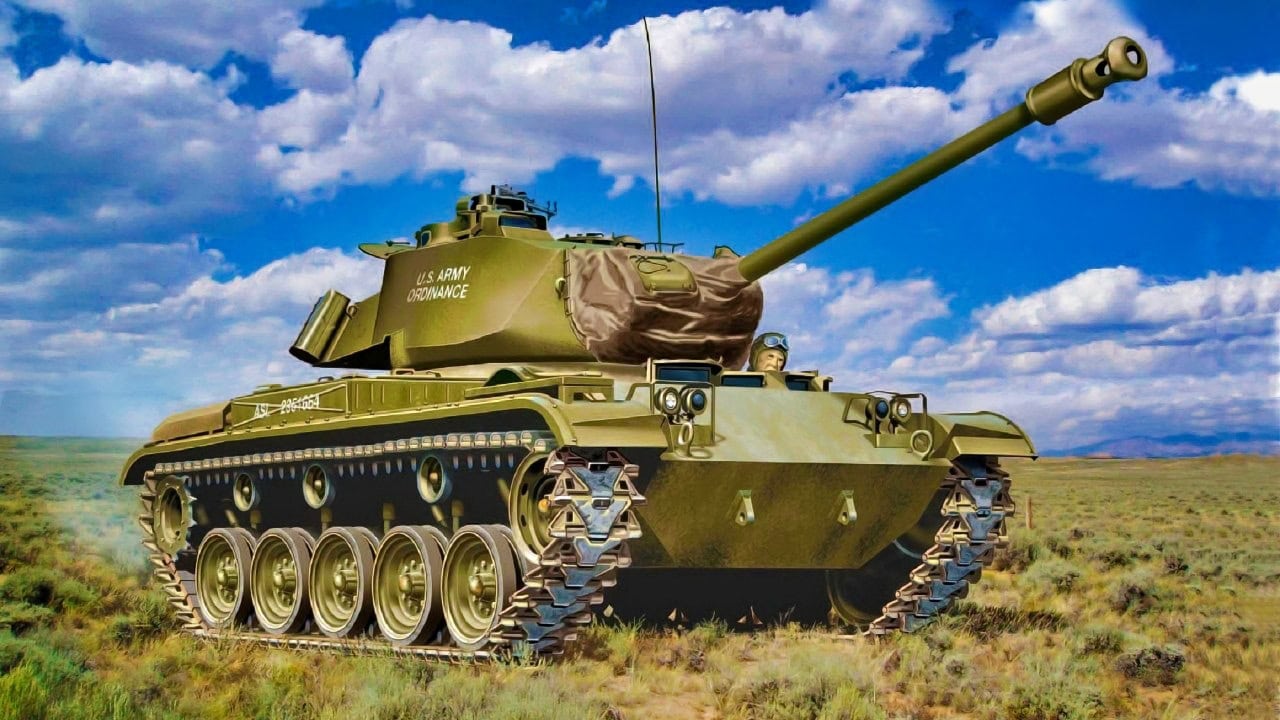Key Points and Summary: The M41 Walker Bulldog was the US Army’s primary light tank during the 1950s and 60s, designed post-WWII to replace the M24 Chaffee with better firepower (76mm gun) and mobility.
-Known for its high speed (45 mph) and agility, it served extensively in reconnaissance and support roles, including during the Vietnam War.
-However, its relatively thin armor proved vulnerable to anti-tank weapons, and its gun became obsolete against newer Soviet tanks.
-Despite widespread export use, the M41 was phased out of US service by the late 1960s, succeeded by the M551 Sheridan, representing an era before light tanks declined.
M41 Walker Bulldog: America’s Speedy Light Tank of the Cold War
In the years that followed World War II, light tanks still had a significant role on the battlefield. They were especially needed to perform scouting and reconnaissance missions. Throughout the 1950s and 60s, the M41 Walker Bulldog was America’s go-to light tank. Nimble and quick, the Bulldog had the speed and firepower it needed for its missions. However, the M41 had a number of issues, and it was replaced in 1969.
Building the Bulldog
The development of the M41 Walker Bulldog began in the late 1940s as a replacement for the aging M24 Chaffee light tanks used during World War II. The M24, while effective during the war, was underarmed against the more heavily armored tanks that emerged toward the end of the conflict. The U.S. Army sought a new light tank with better firepower, mobility, and protection.
The initial design, known as the T37, went through several iterations before being standardized as the M41. The tank featured a 76-mm M32A1 rifled cannon, which was a significant upgrade from the 75-mm gun on the M24. The M41 also included a .30 caliber coaxial machine gun and a .50 caliber Browning M2 roof-mounted machine gun, which gave it considerable secondary firepower.
Developed after the M26 Pershing, the M41 was equipped with torsion-bar suspension that allowed for better cross-country mobility. The tank was powered by a Continental AOS-895-3 six-cylinder air-cooled petrol engine, producing 500 horsepower. The tank’s light weight and engine enabled the M41 to reach surprisingly high speeds of up to 72.4 kilometres per hour (45 miles per hour), making it one of the fastest tanks of its time.
Service History
The M41 entered service with the Army in 1953 and was used extensively during the Cold War. Although it was initially intended for reconnaissance missions, its robust armament and mobility suited it to various combat roles, including infantry support and rapid airborne deployments.
The tank saw action in several conflicts, including the Vietnam War, where it was used by both the U.S. and South Vietnamese forces. Its performance in Vietnam highlighted both its strengths and weaknesses. The M41’s main gun was effective against enemy armor and fortifications. Its high speed, light weight, and suspension all proved valuable in the rough mountainous terrain. While the M41’s speed and firepower were appreciated, its relatively thin armor left it vulnerable to anti-tank weapons.
In addition to its service with the U.S. Army, the M41 was exported to numerous countries. It was used by military forces in Asia, Latin America, and the Middle East, participating in conflicts such as the doomed Bay of Pigs Invasion, the Guatemalan Civil War, and the Lebanese Civil War.
Technical Specifications
The M41 Walker Bulldog had a crew of four: a commander, gunner, loader, and driver. Its dimensions included a length of 5.81 meters (19 feet, 1 inch), a width of 3.19 meters, and a height of 2.72 meters. Because of its light armor, the tank’s weight was approximately 23.49 tons. Even though it weighed so little, the M41 was still considered too heavy, and plans for having it airdropped were later abandoned.
The light weight also meant lesser armor. The tank’s armor was made of welded steel, with thicknesses varying from 9.25 millimeters (0.364 inches) on the hull floor to 31.7 mm on the upper glacis plate. Despite its relatively light armor, the M41’s design emphasized speed and agility, allowing it to perform hit-and-run tactics and reconnaissance missions effectively.
Retirement
The M41 received mixed reviews. On the one hand, it was a significant improvement over its predecessor, the M24, offering better firepower and mobility. Its design influenced the development of future light tanks and armored vehicles.
However, the M41 also faced criticism for its relatively thin armor and cramped interior. The cannon also soon became obsolete with the emergence of Soviet tanks like the T-62 and T-64, which were practically impervious to the M41s gun. These issues, combined with the rapid advancements in anti-tank technology during the Cold War, led to the M41 being phased out of U.S. service by the late 1960s.
Despite this, the tank continued to serve in foreign militaries for many years, with some countries still using upgraded versions of the M41 into the 21st century.
After its retirement, the M41 was replaced by the M551 Sheridan, another light tank that received mixed reviews. Since the Second World War, the need for light tanks has diminished, largely due to advances in anti-tank warfare.
Smaller lightweight designs always come at the cost of protection and firepower, and in the age of drones and RPGs, light tanks simply do not provide enough tactical advantages to justify their lack of protection.
About the Author:
Isaac Seitz, a 19FortyFive Defense Columnist, graduated from Patrick Henry College’s Strategic Intelligence and National Security program. He has also studied Russian at Middlebury Language Schools and has worked as an intelligence Analyst in the private sector.

